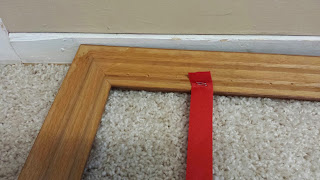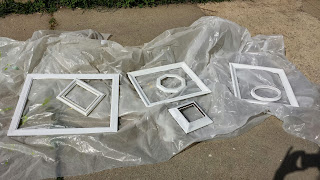I loved the wood grain on the top, the carved details, the art deco handles. However, as you can see it was in pretty rough shape. I figured I would have to paint the whole thing, but I was pretty sure I could give it a new life. I started by peeling of the veneers on the drawers. As you can see they were not good. I did this by putting a damp flour sack towel on top of the veneer, and then putting a hot iron on top untill it got nice and steamy. I then used a putty nive to peel it up. This took some time and patience, but was pretty easy. I kept a big bowel of water nearby to re-wet my towel. Word of warning: this will stain your towel and leave a bunch of residue on your iron. I have read that the iron will clean up nicely with some steel wool, but I frankly have been to lazy to try and I rarely use my iron for its intended purpose. So use a towel you don't care about and an old iron if you have one.
Once the veneer was off I used a little wood filler to patch it up and sanded it down a bit.
Even though I thought I would have to paint the whole thing, I went ahead and started sanding the top, just to see if it was salvageable, and boy am I glad that I did. I started with 80 grit paper and worked my way up to 220 grit. It sanded down beautifully. All the water marks and imperfections came out. So I chose to stain it in a nice dark stain, Moorish Teak, from Zar. Since I already had the sander out, I gave the rest of it a quick sanding to rough it up. I didn't worry getting it perfect since I was going to use my trusty Zinsser primer
Once the stain was dry, I started taping it off so I could paint the rest of it. I used my Zinsser primer so I wouldn't need to sand the entire piece. Just make sure it is nice and clean. I primed it and then gave it two coats of Vintage White in satin from Valspar. I wanted to highlight the carved features of the piece, so I used asphaltum antiquing glaze from Valspar. This was my first time using this glaze and I read a bunch about the best way to use it. I opted to slap it on and wipe it off. I was not a fan of this method on this piece. It did highlight the carved details, but it also just made it look dirty to me. It is a bit hard to tell in the picture below, but trust me.
So I repainted the whole piece again. This time I sparingly used the glaze. I put a little on the brush then brushed most of it off on a paper towel and then applied it to the detail areas and edges, using a cotton cloth to blend it all. I was much happier with the results the second time around.























